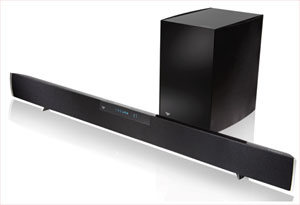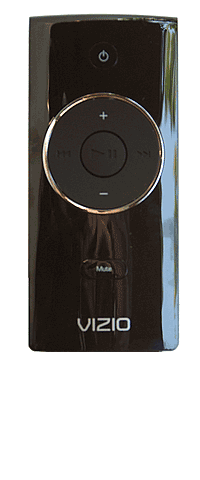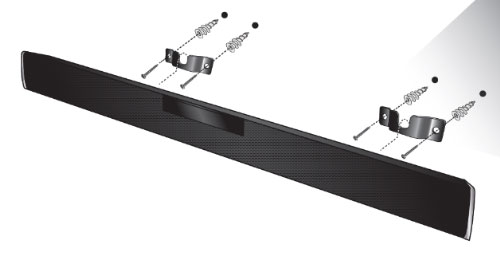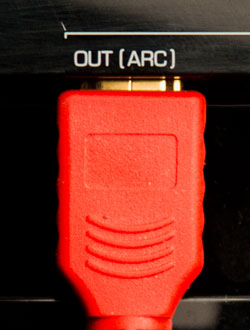
|
|
 |

|


|
VIZIO VHT215 Review
2.1 Sound Bar with Wireless Subwoofer, $269

Dick De Jong Introduction
I've said it before and regretfully, I can continue to state the ugly truth, the sound quality output by most HDTVs simply does not match the picture quality - often, it's not even close. Occasionally, a TV like the JVC JLC47BC3000 is the exception to the sorry sound situation. But with TVs becoming sleeker and their integrated speakers shrinking accordingly, the prospects of improving the audio fidelity seem slim to none. If you actually want to understand that English accent on Downton Abbey or appreciate the soundtrack of the Adele: Live at the Royal Albert Hall Blu-ray, you need a dedicated speaker system. You have two options. If you are building a full-blown home theater, you will want to invest in a surround sound system with at least 5 speakers and a subwoofer, all powered by an AV receiver. Of course, this option could put a major dent in your wallet and the installation can be daunting. A much simpler solution is purchasing a soundbar system like the VIZIO VHT215. It's less expensive and the setup is almost painless. And best of all, the sound quality improvement is quite remarkable. Out of the Box
The whole VIZIO VHT215 package consist of two basic components, the long, slender soundbar (40.1" x 4.1" x 2.1") and the wireless subwoofer (8.5" x 12.8" x 11"), along with a remote and some cables.  The front of the soundbar is covered with black speaker grille mesh with a silver accent on each end. In the middle is an LCD display. The rest of the unit is housed in a glossy black plastic. Inside are four 2.75" Mid-Range Drivers and two .75" Tweeters. On the back are the audio and video connections, which include two HDMI Ins (1.4a with 3D and CEC pass-through), one HDMI Out (1.4a with ARC support, 3D, CEC pass-through), one Optical Digital Audio In (S/PDIF), one Coaxial Digital Audio In (S/PDIF), and one Coaxial Analog Audio In (3.5mm stereo). 
With the right cables and adapters, you could attach up to five devices, such as set top boxes, DVD players, laptops, and tablets, to this soundbar. And then with the remote control, you could switch between inputs. The palm-sized, non-backlit remote looks deceivingly basic with just a Power, Mute, and Volume buttons. The real muscle of this VHT215 soundbar system is hidden in the slide out portion of the remote. Beyond the buttons for selecting the various inputs and those for adjusting the subwoofer volume and for tweaking Bass and Treble, are the controls for activating the SRS options like TruSurround HD, WOW, and TruVolume. I'll talk about them more in the next section. Setup
Before discussing connections and adjustments, let's deal with simple placement issues. VIZIO advises that you place the soundbar "centered and below the TV, as close as possible to ear level for seated viewers." This is a sound suggestion. The only problem is that the soundbar is about four inches high. If your TV is sitting on a stand and you place the soundbar in front of it on the stand, the VHT215 will usually block the TV's remote control receiver. Even if you remove the little soundbar feet, it will probably still block the TV's remote from working. One solution is to attach the soundbar below the TV with the supplied mounting brackets. If your TV is already wall mounted, then attaching the soundbar below it seems like a natural solution. Of course, if you persist on perching your TV above your fireplace, then when you position the soundbar, at least rotate it down so that the speakers are aimed at where you sit. Placing the soundbar appropriately will greatly increase your appreciation of it.  Where you put the subwoofer is not as critical, though VIZIO suggest that it "will perform best when located in a front corner of the room." Since the subwoofer is wireless, you have more leeway in exactly where it goes because you don't need to worry about running speaker wires. But the subwoofer does have to be plugged into a wall socket for its power. The 2.4 GHz wireless subwoofer and soundbar are paired in the factory, which relieves you of that duty. You simply power them up and they communicate with each other. Once situated, you can commence plugging in all your devices. For many of you that will entail attaching items like a set top box or a Blu-ray player directly to the connections on the back of the VHT215. 
If you are lucky enough to have a newer model TV with Audio Return Channel (ARC) support, then you can plug your audio and video equipment directly into the TV and run a single HDMI cable to the VHT215. You would then switch inputs using your TV, but the audio portion of the signal would be routed to the soundbar. One advantage of this setup is that you can control the volume with your TV's remote. This is how I set up my TV for testing and the procedure was plum easy. Now, I have read that other folks have pulled their hair out trying to get ARC equipment to communicate with each other. If you don't have any luck, you can always plug the devices directly into the VHT215. Actually, you may want to do that anyway with certain ones, like MP3 or CD players. Once you are all connected, the fun begins. You can start playing your favorite movies or CDs and begin experimenting with the various SRS sound enhancements. VIZIO does offer a few suggestions on applying the SRS functions like TruSurround HD and WOW. They recommend that you use TruSurround HD for movie/TV content. For music content, SRS WOW HD is their choice. Ultimately though, your ears will be the judge of what sounds best in your room. Performance
If you are used to the audio coming from your TV, the sound quality from the VIZIO VHT215 will be startling better. The soundbar can fill a medium sized room with high fidelity and the subwoofer adds the low-end depth that makes the aural experience richer, especially for action movies.  For music, the clarity and separation of instruments is very good, which is ideal for enjoying sources like Pandora. The music does actually seem to be emanating from beyond the ends of the soundbar. But for me, who appreciates wonderful writing, the biggest boon is that with the VHT215, I can hear dialogue more clearly. I will admit that I still activate Closed Captions occasionally to decipher a mumbled aside. But for most TV shows, I don't have to strain to ascertain what's being said. Now, if you want that true surround sound experience, with bullets ricocheting off the wall behind you, then the VHT215 is not your huckleberry. You'll require a system with separate surround speakers that you place around the room. But for those that don't want to incur the expense of a full blown 5.1 or 7.1 surround system, the VIZO VHT 215 is a good alternative. Value
Do I wish that TV manufacturers would integrate high quality sound systems into their TVs so that products like soundbars would not be necessary? Heck, yes! But with companies trying to shave every penny off their costs, Lucifer will be serving snow cones before we see TVs like that again. Therefore, the question becomes, how much should you pay for quality sound? More specifically, what is a good value for a soundbar system? The VIZIO VHT215 retails for around $270, which seems like the current sweet spot for budget, but good quality, soundbars. (As a point of reference on the high-end, Martin Logan just announced a single-speaker 5-channel surround soundbar for $1500.) If you have an HDTV that cost over $500 and you are constantly straining to hear dialogue or are underwhelmed with its room filling capability, then I would say that $270 for the VHT215 is a good value.  Conclusion
The VIZIO VHT215 2.1 soundbar system performs admirably in clarifying dialogue, amplifying action movies, and simply elevating your TV's sound quality. With a wide array of inputs and a wireless subwoofer, the VHT allows you to easily and inexpensively install and expand your home theater sound system. |
Bookmark:
![]() del.icio.us
del.icio.us
![]() Reddit
Reddit
![]() Google
Google
| Send this Page | Print this Page | Report Errors |

